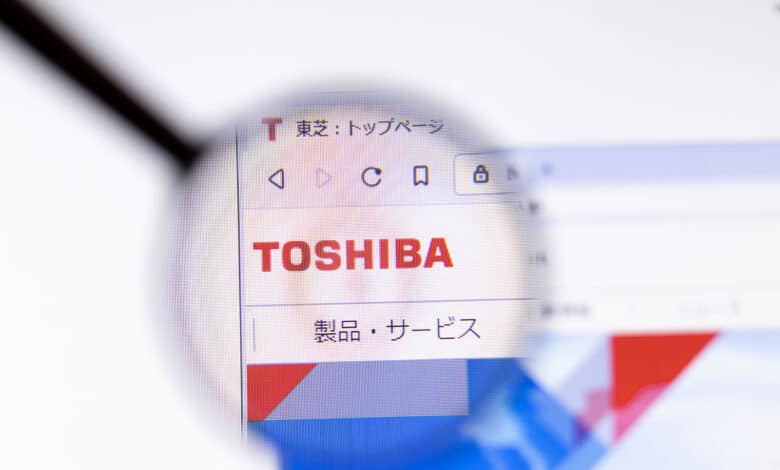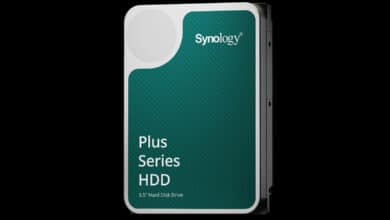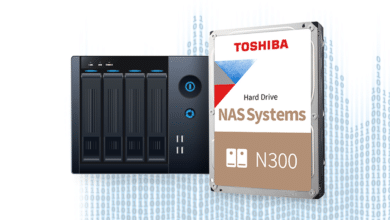
Toshiba is considered one of the most popular manufacturers of storage media. However, the company does not seem to be satisfied with the storage capacities achieved so far. It has now become known that the storage experts from the Far East are working at full speed on other solutions that are supposed to pave the way for more storage space.
To date, a maximum of 18 TB at Toshiba
Currently, Toshiba is researching techniques that should make it possible to build HDDs with more than 30 TB. The jump to over 30 TB sounds really impressive. After all, the company currently offers a maximum of 18 TB of storage. The special HDDs with 18 TB are based on a technology called Flux Control-Microwave Assisted Magnetic Recording (FC-MAMR). According to Toshiba, even 20 TB should be possible in theory. However, the end of the line will soon be reached. In order to be able to handle higher capacities beyond 30 TB, a completely new technology would have to be developed. This includes not only new write heads, but also a completely newly developed medium. To make this ambitious goal a reality, Toshiba has enlisted the help of experts from SDK and TDK. Together, they want to help the HDD market, which was thought to be dead, to new heights.
HDDs are not dead
In the end customer sector, one can clearly observe the trend that classic magnetic hard disks are hardly used anymore. The reason for this is the great advantages that SSDs bring with them. They are not only faster, but also more resistant and come in more compact dimensions. But there is also one point where the HDD is still ahead – storage capacity. Normal consumers will not mind that the notebook SSD only offers 512 GB or 1 TB of storage space. After all, cloud solutions ensure that you no longer need too much storage capacity on your computer. But in the professional sector, it is essential to also store large amounts of data on corresponding data carriers.

Companies involved in the data storage industry are therefore working meticulously to squeeze every last megabyte out of the hard drive. To do this, they need to increase the areal density of a magnetic hard disk. However, it seems that with the current technology, there is simply no more to be had. New technologies are needed and Toshiba seems to be able to offer them. The manufacturer is the first to use HDDs with Microwave Assisted Magnetic Recording (MAMR). This term is not new for experts in the field of storage media. After all, Western Digital (WD) already wanted to rely on this technology as a big Toshiba competitor. While WD finally decided against it, Toshiba is apparently in the middle of the development.
Just a pilot project?
It is clear that Toshiba does not want to launch a full-fledged MAMR yet. However, this is necessary if a manufacturer wants to launch HDDs that offer more than 30 TB of storage space. In particular, this is called Microwave Assisted Switching-Microwave Assisted Magnetic Recording (MAS-MAMR). The big difference to the FC-MAMR already used so far? MAS-MAMR is unfortunately not compatible with the current basis of HDDs. FC-MAMR seems to get the maximum out of this. Accordingly, the HDD has to be adapted to the new technology. Especially the recording medium is affected. A trio of Toshiba, SDK and TDK has now taken on this mammoth task.
Research on HDDs with more than 30 TB
Toshiba has enlisted the support of experts for the development of its gigantic data carriers. For one thing, Shōwa Denkō (SDK), a real expert in the manufacture of HDDs, is on hand to offer advice and support. The chemical company from Japan has now officially announced that it is working on MAS-MAMR and is supporting Toshiba in the development. According to the SDK, MAS-MAMR with its MAS effect offers the possibility to slim down the track for data recording. This is said to result in more recording tracks being able to fit on just one disc. The bottom line is that this allows, at least theoretically, more data to be stored on the same number of magnetic disks. And here comes the real sticking point, which the companies involved are probably racking their brains over at the moment.
In order to be able to use this so-called MAS effect, the HDD must first be prepared accordingly. In particular, the read and write heads of the hard disk must be prepared. And this is where TDK comes into play. The company, which is also based in Japan, is to complete the trio and take care of the development of read and write heads. The three companies have one goal in common. In the long term, they want to be able to manufacture HDDs that offer a storage capacity of over 30 TB. However, before the “data messis” among you start doing somersaults, we have to put a damper on things. It will probably take some time until Toshiba, SDK and TDK have put their plans into practice.
The competition doesn’t sleep
But what about the other renowned experts for storage media? As we already mentioned at the beginning, WD has meanwhile moved away from its plans around the MAMR technology. But that does not mean that the company is not working on alternatives. Quite the opposite! Unlike Toshiba, WD wants to focus on so-called energy-assisted PMR. Furthermore, the manufacturer is currently primarily focused on increasing storage capacities in the flash memory sector. Here, WD has only recently managed to enable storage capacities of 20 TB thanks to OptiNAND.
However, the company has obviously not completely abandoned the MAMR technology yet. One can rather speak of postponed instead of cancelled here. The company also brings another technology into play. The so-called Heat Assisted Magnetic Recording (HAMR) relies on laser technology and is also supposed to enable storage capacities of over 30 TB. However, according to its own information, WD only wants to use its new technology when the magic sound barrier of 30 TB has been reached.
Seagate is also extremely active in the field of maximizing storage capacities. However, MAMR is not an issue for the company. Instead, the US company wants to rely on laser-based HAMR technology. Unlike WD, the company does not want to wait to use the novel technology. Instead, Seagate is already testing its HAMR technology to build comparatively small HDDs with a capacity of 20 TB, for example. However, according to the company, these should only serve testing purposes.
Additional magnetic disk as an interim solution?
While the various manufacturers are researching, the customers’ expectations are naturally high. These want to receive an increase in the maximum possible storage capacities at regular intervals. Seagate has made it clear with its PMR-based 20TB HDDs that sometimes the solution can be straightforward. Thus, the company simply installed another magnetic disk for the data without further ado. A total of ten disks are used – a first in the field of 3.5-inch HDDs. As simple as the solution to the problem may sound, the other manufacturers also seem to find the approach ingenious. WD and Toshiba have now also announced that they will probably install another data disc in the future. We are curious which technology will finally prevail in the HDD sector.



